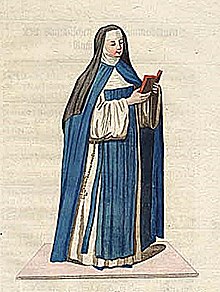Cölestinerinnen
The Cölestinerinnen (Latin Ordo SS. Annuntiationis , "Order of the Most Holy Annunciation"), sometimes also called "Italian Annuntiatin women", are a contemplative order in the Roman Catholic Church .
Designations
After the light blue color of her choir mantle and scapular that over a white tunic to be worn, called the sisters sometimes "sky-blue Order of the Annunciation of the Blessed Virgin Mary ", Italian Annunziate celesti ( "heavenly Annunziatinnen"), hence the German name Cölestinerinnen . In Rome the name "Turchine" ("the violet- blue ones ") is common. The order is to be differentiated from the French Annuntiatinnen , who in 1501 from St. Jeanne de Valois had been founded; these in turn are also called "red annunciators" after the color of their scapulars.
Order history
Blessed Maria Vittoria De Fornari Strata founded this order in Genoa . Pope Clement VIII confirmed him on August 5, 1604 and ordered that the nuns should live according to the Augustine rule. The order is an association of independent monasteries, which are led by a prioress and are subject to the jurisdiction of the respective local bishop .
Duke Wolfgang Wilhelm von Pfalz-Neuburg invited the Cölestine women to Jülich-Berg as early as 1639 , where they settled in the state capital Düsseldorf (on the site of today's Palais Spinrath ). From there, the sisters founded a branch convent in 1729 by acquiring the former White Women's Monastery in Aachen , which was secularized in 1802. This included Maria Sophia Josephina Valckenberg (1758-1844) and Maria Magdalena Wilhelmina Valckenberg (1761-1830), who were older sisters of the mayor of Worms Peter Joseph Valckenberg . The grave cross of the latter has been preserved in the old cemetery in Worms , identifying them as “former choirs of the Cölestiner order in Aachen”.
The Italian Empress Eleonora founded the Cölestinerinnenkloster in Steyr in Upper Austria in 1646 , which was abolished in 1784 by Emperor Joseph II . The same fate suffered in 1782 for the daughter monastery founded by the Annuntiate Sr. Maria Viktoria von Sarnthei (1666–1737) near Rottenbuch Castle in Bolzano . Count Franz Anton von Sporck (1662–1738) arranged for the establishment of a Cölestinerinnenkonvent in Gradlitz , Bohemia , because his daughter Maria Eleonora (1687–1717) belonged to the order. In 1736 he founded another branch in Prague .
There are currently two monasteries of the Order in Italy; one in Genoa and one in Rome, which was founded in 1676 by Camilla Orsini Borghese (Madre Maria Vittoria, 1603–1685), Princess of Sulmona . Her husband Marcantonio Borghese (1598–1635) was a nephew of Pope Paul V. The Roman monastery has had a branch convent in Manila , Philippines , since 1995 .
The mathematician Maria Gaetana Agnesi (1718–1799) had been a member of the order since 1771. Grand Duchess Anna Maria Franziska of Tuscany was buried in 1741 at her own request in the blue choir cloak of the Cölestine nuns .
literature
- Antoine Henri de Bérault-Bercastel: History of the Church in a Faithful Excerpt , Volume 7, p. 382, Innsbruck, 1843; (Digital scan)
- Joseph Wendt von Wendtenthal: History of the entire Austrian, secular and monastic clergy beyderley sex , 3rd part, 6th volume, pp. 294–299, Vienna, 1784; (Digital scan)
Web links
Individual evidence
- ^ Website on Maria Vittoria De Fornari Strata
- ↑ Ulrich Brzosa: The history of the Catholic Church in Düsseldorf: From the beginnings to secularization , Böhlau Verlag, Cologne, 2001, pp. 308-314, ISBN 3412119008 ; (Digital scan)
- ^ Journal for historical research , Duncker & Humblot, 2006, page 374 of the volume, footnote 75; (Detail scan)
- ↑ Website on Maria Sophia Josephina Valckenberg, with a scan of her death picture
- ↑ Website with details on Maria Viktoria von Sarnthein ( Memento from December 23, 2004 in the Internet Archive )
- ↑ Website on the history of the Bolzano Cölestinerinnenkloster
- ^ Robert Stupperich: Westfälische Lebensbilder , Volumes 11-12, Aschendorf Verlag, 1975, p. 225; (Detail scan)
- ↑ Milada Vilímková, Johannes Brucker: Dientzenhofer: a Bavarian master builder family in the baroque era , Rosenheimer Verlag-Haus, 1989, p. 126, ISBN 3475526107 ; (Detail scan)
- ↑ Karel Vladislav Zap: Guide through Prague , Prague, 1848, pp. 168 and 169; (Digital scan)
- ↑ Cynthia Lawrence: Women and Art in Early Modern Europe: Patrons, Collectors, and Connoisseurs , Penn State Press, 1999, pp. 176-180, ISBN 0271042354 ; (Digital scan)
- ↑ Website on the history of the Roman monastery foundation (sub-item: History)
- ^ Order website with mention of the convent in Manila
- ^ Max Heimbucher : The orders and congregations of the Catholic Church , Volume 1, p. 627, Verlag Ferdinand Schöningh, 1933; (Detail scan)
- ^ Website on the life story of the Grand Duchess
- ^ Ferdinand Břetislav Mikovec : Picturesque-historical sketches from Bohemia , Vienna, 1860, p. 65; (Digital scan)


